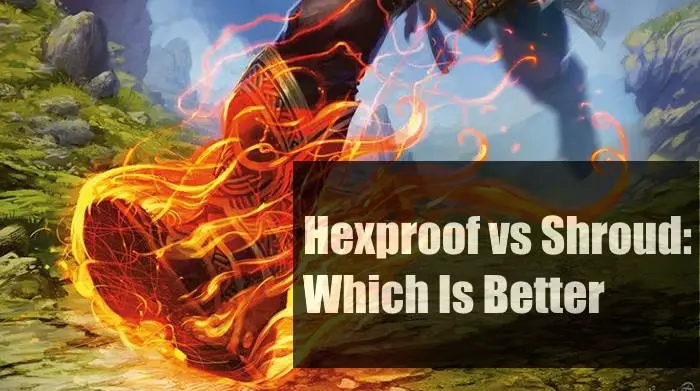Protecting your threats is one of the best ways to ensure that you’ll win a game of Magic. In particular, shroud and hexproof can stop your opponents from dealing with your
Usually, hexproof is the stronger choice. A permanent or player with shroud can’t be targeted by anyone, including you. Hexproof only stops your opponents’ spells and abilities, so you can still use your own effects. This means that hexproof cards can still interact with the rest of your deck, but shroud cards cannot. However, there are some cases in which cards with shroud are just as effective, or even preferred over cards with hexproof.
Shroud and hexproof are incredibly similiar, but fully understanding how they differ can give you an edge both in deckbuilding and in gameplay. This article is a comprehensive guide to understanding both shroud and hexproof, and it will teach you how to use these mechanics to improve your decks. It also includes key play patterns so you can use these mechanics to their full potential.
What’s the Difference between Shroud and Hexproof?
In most cases, hexproof is better than shroud. Before we can delve into why, however, we need to understand how these two mechanics work. They are quite similar, but the difference between them can make a huge impact in your games.
How Does Shroud Work?
If a permanent or player has shroud, it means that spells and abilities cannot target them. The critical word to pay attention to here is ‘target’. A spell or ability has to specifically use the word ‘target’ in order for shroud to protect against it.
Let’s look at Pyre Spawn from Innistrad: Crimson Vow as an example. When it dies, it deals three damage to any target. However, if a creature or player had shroud, it would be illegal for Pyre Spawn’s ability to target it. The player controlling Pyre Spawn would have to choose another target entirely.
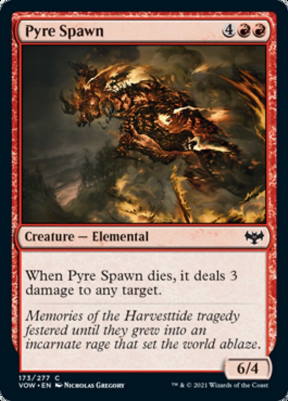
How Does Shroud Work with Equipment?
Some cards don’t have the word ‘target’ explicitly written on them, but it can still be found in the card’s rules text. A good example is equip, which is shorthand for:
“Attach this permanent to target creature you control. Activate only as a sorcery” (Rule 702.6).
MTG Wiki
Even though individual equipment cards might not have ‘target’ in the text box, their equip ability does target creatures. This means that creatures with shroud are illegal targets for this ability.
Once a creature has been equipped, it will stay equipped even if it gains shroud later in the game. This is because spells and abilities only have targets when they’re on the stack, not once they’ve resolved. After the equip ability has resolved, the equipment is just attached to a creature, so it won’t continuously target it.
RELATED: MTG Equipment – Everything You Need to Know
There are other cards, such as auras, that use ‘target’ in their rules text without writing out the word on the card. If you aren’t sure if a certain mechanic targets or not, check its rules text or reminder text.
While shroud offers great protection, it also stops your spells and abilities. In the case of equipment, you wouldn’t be able to equip your own shroud creature, and you also wouldn’t be able to use auras, pump spells, or any other beneficial effects that target. Shroud’s biggest weakness is its symmetry: not being able to target your own permanents can really limit your lines of play.
How Does Hexproof Work?
Hexproof works a lot like shroud. Any permanents or players with hexproof can’t be targeted by spells or abilities their opponents control. The important distinction here is that you can still target anything you control with hexproof (including yourself).
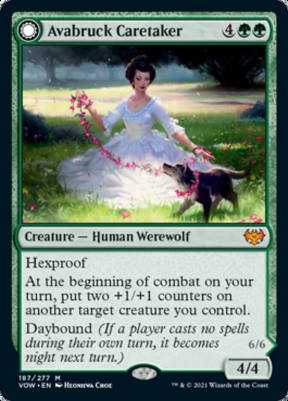
Being able to target your creature while knowing it’s safe from your opponents can make a huge difference in a game. The Bogles archetype in Modern is even built around this idea.
RELATED: MTG Modern: A Getting Started Guide
A Bogles deck runs a few cheap creatures with hexproof alongside plenty of aura spells to buff them up. Normally, putting all your eggs in one basket is a risky strategy in Magic. One removal spell would not only destroy the creature, but all of the auras attached to it as well. If that creature has hexproof, though, then it’s much harder to deal with.
Hexproof doesn’t just protect you from your opponent’s spells and abilities; it also creates new strategies and play patterns based on that protection.
Why is Hexproof Better than Shroud?
By now, you’ve likely figured out why hexproof is the stronger keyword. Both offer the same level of protection, but hexproof doesn’t limit your options. In fact, it can allow you to create a powerful threat that your opponents will struggle to remove.
It isn’t often that keywords are strictly better than others in Magic, but there isn’t much of a reason that you’d rather have shroud over hexproof. If your opponent casts Emrakul, the Promised End and controls you during your next turn, it’s probably better if your creatures have shroud. Besides that, there isn’t anything that shroud offers you that you can’t also get from hexproof.
Shroud Pros and Cons
| Pros | Cons |
| Excellent protection | Cannot target your own permanents |
Hexproof Pros and Cons
| Pros | Cons |
| Excellent protection | None |
| Lets you target your own permanents |
When Would I Want to Play Shroud?
As debates often are in Magic, comparing shroud and hexproof is more complicated than just saying hexproof is better and calling it a day. On paper, hexproof is just a strictly better keyword, but there are still shroud cards which are more efficient than their hexproof counterparts.
Lightning Greaves vs Swiftfoot Boots
Lightning Greaves is a great example of a highly efficient shroud card. It’s an equipment that costs two mana, and it gives a creature haste and shroud for an equip cost of zero. Compared to Swiftfoot Boots, which gives hexproof instead of shroud and has an equip cost of one, Lightning Greaves can save you a ton of mana over the course of a game.
That one mana difference may not seem huge, but it can really add up. The fact that Lightning Greaves has a free equip cost also allows it to get around the restrictions of shroud.
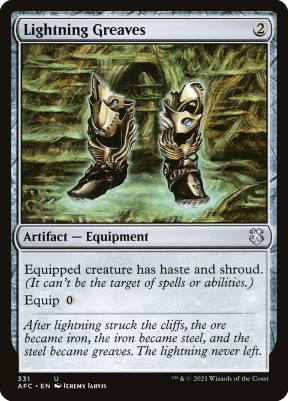
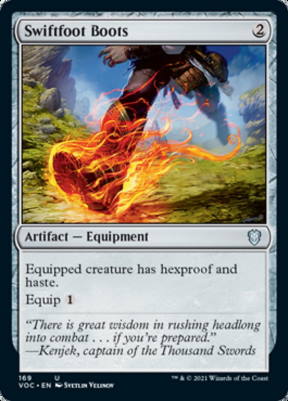
If you have two creatures, you can move Lightning Greaves between them as many times as you want. After all, it doesn’t cost any mana to activate Lightning Greaves! This means that if you need to target one of your creatures, you can move the greaves to the other so that the first creature loses shroud. After that, you can use your spell or ability and then move the greaves back.
This dance only works at sorcery speed, and it does give your opponents a window to remove your creatures. Still, this play pattern allows you to bypass shroud’s biggest weakness, so it’s definitely worth using if the situation calls for it.
I find myself including Lightning Greaves in a variety of decks just because it offers some of the most efficient, long-lasting protection in the game. Whether I need to protect key creatures or run cheap yet powerful equipment, Lightning Greaves is a card that I find difficult to cut.
Lightning Greaves’ free equip cost makes it stronger and more flexible than Swiftfoot Boots. It even gets around the one downside of shroud. This is certainly a case where the hexproof card isn’t clearly better than its shroud counterpart.
Guidelines On Using Shroud
Analyzing Magic cards is more complex than looking at just one factor, such as whether it has shroud instead of hexproof. When evaluating a card, you should consider its mana cost, potential synergies, unique lines of play, everything. Sometimes a card with shroud will be the best fit for your deck even though hexproof is the stronger keyword.
There are also some decks that don’t target their own
A Quick Note On Ward
Ward is a newer mechanic that forces your opponent to pay an extra cost to target your permanents. This cost could be anything from mana, life, or discarding cards, but they have to pay it to prevent their spell or ability from being countered.
RELATED: MTG Ward: How It Works
In recent sets, ward has taken hexproof’s place as the standard protective keyword. Still, it usually isn’t as powerful as shroud or hexproof. Ward has to demand steep costs before it becomes comparable to these two. Although discarding a card or paying four mana are tough costs to pay, most ward costs are just one or two mana.
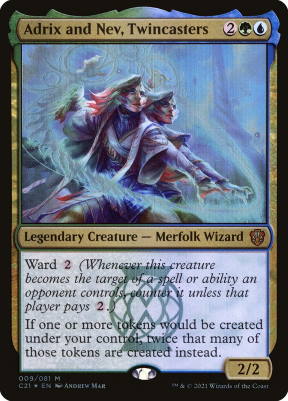
Ward is great for slowing down your opponents, but it isn’t guaranteed protection like shroud and hexproof.
In fact, I don’t treat it like these mechanics in my evaluation at all. I think of ward in the same way as other evergreen mechanics like menace or trample: it’s a nice bonus that certainly improves the card, but it just doesn’t compare to the raw power of shroud and hexproof. Your opponents will usually be able to bypass ward if they need to, but the same can’t be said for shroud and hexproof.
If you need to keep your permanents safe in order to win, don’t expect ward to consistently work for you.
FAQ about Shroud and Hexproof
We’ve already learned a lot about how shroud and hexproof work, but let’s address some of the most common questions when it comes to these two mechanics.
Can I Use Shroud or Hexproof to Counter Spells?
Yes! There are many instant speed effects that will give a creature shroud or hexproof, and they can be used to fizzle spells.
Let’s say that your opponent targets your Birds of Paradise with Swords to Plowshares. If you respond by casting Heroic Intervention, your Birds of Paradise will gain hexproof. Once it’s time for Swords to resolve, your creature is no longer a legal target and the spell targeting it will fizzle. Your opponent’s spell won’t resolve, and you’ll get to keep your Birds.
If a spell has multiple targets, giving just one of them hexproof isn’t enough to fizzle the spell. Against Hex, for example, the spell will still resolve even if some of the target creatures gain shroud or hexproof. In this case, Hex would ignore any illegal targets but destroy the rest.
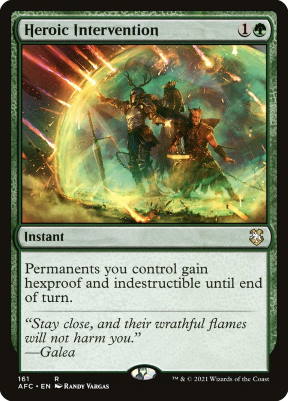
Sometimes you’ll care more about protecting your permanents than fizzling the spell entirely, but some spells have other effects. If a removal spell also lets your opponent draw cards or gain life, for example, they would do so as long as some of the spell’s targets were still legal.
Can Cards with Shroud or Hexproof be Countered?
Yes, your opponents’ counterspells work against cards with shroud and hexproof. This is because your cards don’t have these keywords while they’re on the stack. They only gain their keywords once they have resolved and become permanents. Carnage Tyrant, for example, has “This spell can’t be countered,” even though it also has hexproof.
Because these cards don’t have shroud or hexproof on the stack, they can be targeted by more than just counterspells. They can be returned to your hand, copied, or have any number of shenanigans done to them. These cards are only protected once they resolve.
Do Board Wipes Kill Creatures with Shroud or Hexproof?
Yes, sadly shroud and hexproof do not protect against
This example shows that permanents with shroud and hexproof can still be affected by other cards. So long as they aren’t being targeted, these keywords won’t do anything to protect you and your cards.

As another example, sacrifice effects don’t typically use targets. If a player casts Mire in Misery, you might still have to sacrifice a creature with shroud or hexproof. You never ‘target’ the creature you sacrifice, you just choose which one is heading to the graveyard. It’s also important to note that if you, the player, have hexproof, you’ll still have to sacrifice something. Mire in Misery doesn’t target players, either: it just says “Each opponent.”
Conclusion
It’s hard to find better protection in Magic than shroud and hexproof. Both keywords can stop your opponents from interacting with your
